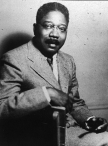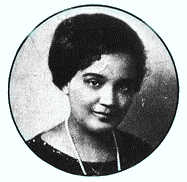| W. E. B. Dubois, Aaron Douglas, and Jessie Fauset in the 1920's and 30's all seem to be part of an elite, college-educated group of African-Americans somewhat secluded from "the masses." The people in this group were for the most part friends with each other but often didn't understand the needs of poor black families in racist areas. And the reason for this was that many of the factors enabling these people to assume leadership roles (such as the availability of money, mental aptitude, etc.) put them out of touch with other, less fortunate, members of the race. | ||
 Aaron Douglas
Aaron Douglas
|
Aaron Douglas had many of these fortuitous qualities. First of all, he was very talented from an early age - visitors to his home often asked his family who they had gotten the artwork from. He also, much like W.E.B. Dubois, lived in an area where poverty and racism were rare, and went to school with many whites. From this he (and Dubois) knew that it was very possible for the two races to coexist happily, but didn't understand how hard that was to achieve in places where racism was deeply ingrained in society. Third, he got a college education, majoring in History of Art. And finally, also like Dubois, his remarkable ability made it easy for him to secure jobs and to study with other famous black artists. | |
| Douglas was probably also similar to Dubois in that he thought at first that his artwork would touch people to the extent of bringing equality. He expressed his ideas visually, not verbally, because he felt he could do it best that way, and indeed he did it well. His artwork was amazing: with black silhouettes, layered shapes, contrasting sharp edges and soft colors, a sense of the progression of time. But he must have realized eventually, like Dubois did, that equality would not come so easily, and that everyone was not as lucky as he. This helps explain why he became the first president of the "Artists' Guild" - to help other burgeoning black artists find jobs. He also started the Arts department at Fisk University. | ||
 Jessie Fauset
Jessie Fauset
|
Jessie Fauset's childhood is extraordinarily similar to that of Dubois and Douglas. She grew up in an all-white neighborhood and was the only black in her high school class. She was bright, and attended Cornell College, studying "classical" literature there. She had to teach for 15 years in order to make enough money to do what she really liked - writing - but getting a job at Fisk University (where Dubois had been and Douglas was soon to be) couldn't have been very hard for her. As with Dubois, exposure to the South meant more exposure to racism, and led to her increased commitment to the race struggle. | |
| Fauset's relationship with Dubois exemplifies the proximity between "members" of this so-called group of educated, elite blacks. The two worked together on The Crisis magazine: Dubois was editor, and Fauset was a contributing writer, although she sometimes helped with editing tasks when needed. Apparently Dubois acted as teacher, mentor, good friend, and almost a father figure to Fauset; there are even rumors of them having an affair. Their beliefs coincided chiefly in that they strove to prove blacks and whites similar as opposed to "different, and good that way" - Fauset often used light-skinned characters in her writing, and focused on basic values and similarities to white culture. | ||
| Aaron Douglas was also familiar with the two, designing many covers for The Crisis. And Jessie Fauset was similar specifically to Douglas in that she helped many other young black artists along. One of the many things she did was edit the children's magazine The Brownies Book which included writings and artwork of many young African-American artists. | ||
| So there was definitely a group, almost a clique, of blacks with similar backgrounds, social class, and views. They were very influential, but there was a whole other "camp" which seems to have offered most of the spirit of the Harlem Renaissance - the spirit of celebrating blacks' differences and expressing a new pride in the race. These two groups got along with each other - it was certainly in the race's best interest to do so - but had different styles and values. Langston Hughes is noted as being reviewed positively by Fauset, even though his style was vastly different, somewhat like Zora Neale Hurston's writing. I look forward to learning about other such artists who didn't fit so well with the "elitists;" artists who learned to celebrate their differences. | ||
€ An Elite Group of African-Americans
€ A New Way to Treat Racism
€ Admiring the Differences
€ Unsung Heroes of Black America
€ A Lot of Creative, Inspiring People